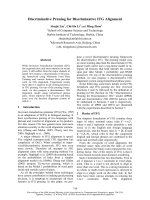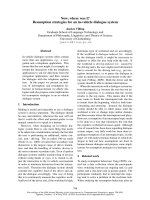Báo cáo khoa học: "Deep Learning for NLP" pptx
Bạn đang xem bản rút gọn của tài liệu. Xem và tải ngay bản đầy đủ của tài liệu tại đây (61.36 KB, 1 trang )
Tutorial Abstracts of ACL 2012, page 5,
Jeju, Republic of Korea, 8 July 2012.
c
2012 Association for Computational Linguistics
Deep Learning for NLP (without Magic)
Richard Socher Yoshua Bengio
∗
Christopher D. Manning
,
Computer Science Department, Stanford University
∗
DIRO, Universit
´
e de Montr
´
eal, Montr
´
eal, QC, Canada
1 Abtract
Machine learning is everywhere in today’s NLP, but
by and large machine learning amounts to numerical
optimization of weights for human designed repre-
sentations and features. The goal of deep learning
is to explore how computers can take advantage of
data to develop features and representations appro-
priate for complex interpretation tasks. This tuto-
rial aims to cover the basic motivation, ideas, mod-
els and learning algorithms in deep learning for nat-
ural language processing. Recently, these methods
have been shown to perform very well on various
NLP tasks such as language modeling, POS tag-
ging, named entity recognition, sentiment analysis
and paraphrase detection, among others. The most
attractive quality of these techniques is that they can
perform well without any external hand-designed re-
sources or time-intensive feature engineering. De-
spite these advantages, many researchers in NLP are
not familiar with these methods. Our focus is on
insight and understanding, using graphical illustra-
tions and simple, intuitive derivations. The goal of
the tutorial is to make the inner workings of these
techniques transparent, intuitive and their results in-
terpretable, rather than black boxes labeled ”magic
here”.
The first part of the tutorial presents the basics of
neural networks, neural word vectors, several simple
models based on local windows and the math and
algorithms of training via backpropagation. In this
section applications include language modeling and
POS tagging.
In the second section we present recursive neural
networks which can learn structured tree outputs as
well as vector representations for phrases and sen-
tences. We cover both equations as well as applica-
tions. We show how training can be achieved by a
modified version of the backpropagation algorithm
introduced before. These modifications allow the al-
gorithm to work on tree structures. Applications in-
clude sentiment analysis and paraphrase detection.
We also draw connections to recent work in seman-
tic compositionality in vector spaces. The princi-
ple goal, again, is to make these methods appear in-
tuitive and interpretable rather than mathematically
confusing. By this point in the tutorial, the audience
members should have a clear understanding of how
to build a deep learning system for word-, sentence-
and document-level tasks.
The last part of the tutorial gives a general
overview of the different applications of deep learn-
ing in NLP, including bag of words models. We will
provide a discussion of NLP-oriented issues in mod-
eling, interpretation, representational power, and op-
timization.
5









